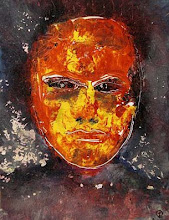Protest-images of corruption and moneyhunger
Under the painting: Zlatko Dolic’s dark painting of cityscape in ruins is reflecting industrialism and capitalism. The bar-code can be interpreted as the contemporary golden calf.
- We will all be radioactive in the future, says the debutant artist Zlatko Dolic. Sorrow and rage mark his exhibition Backstage of the Reality at the city hall in Söderköping.
Last saturday BlandArt had its second summerguest exhibition in Söderköpings Lilla Galleriet. Zlatko Dolic is the name of the 30 yearold debutant artist. Eleven years ago, he came to Norrköping from Bosnia and has for last six years been working as screenprinter in a local company. During last four years he has actively been painting his protest-images which not only represent the memories of the catastrophic events in homeland but are also highlighting all the superiority, moneyhunger, corruption and destruction in the world.
- As I see it, this reality is hidden backstage and that is where I am too, observing and projecting my imprressions onto the sheet, he says during our encounter.
The exhibition consists of fully 20 images, twelve of which depict characters, encompassed in dramatic mental agitations and intense emotions. Through these images he also expresses his own moods that often portray sorrow and rage. The events taking place arround the world are having a great impact on him.
The leaflet image of the exhibition is a small painting illustrating a black, shattered cityscape. The factory chimney behind the thick mists of air pollution symbolize industrialism and capitalism, explains Zlatko Dolic. Also the screened bar-code at the upper left corner is a sign of these odious phenomena. The bar-code is the golden calf of present-day.
In the forefront of this distrustful image the tragic human character emerges. Its figure is surrounded by an aura of effervescent radiationbelt.
- It’s a most ordinary human showing us what we will look like in the future if we continue ignoring our problems. We will all be radioactive, clarifies Zlatko.
The little human on the image is dejected, the despair is plain. There seem to be no future. However, the sky above is surprisingly full of delicate light and shade and is looking promising blue, even if the its shade is pale.
The colour is spread out as a thin layer over the cardboard surface that he paints and scrapes. Zlatkos choice of tools and methods is extremely unorthodox. The UV-colour, i.e. the industrial tint for screenprint, is worked up and applied with bare fingers, a knife, a rock or whatever is at hand.
The twelve characters are, as mentioned, depicting various mental disturbances and emotions. What they all got in common is their resemblance to earless masks.
- People cry out for help yet noone hears, so what good would ears bring then, says Zlatko. Noone cares. We see everything but noone want’s to hear. This is the dilemma since there is so much dreadful stuff going on arround the world.
A twofolded character with ambitious rising wire-horns displays sadness in its eyes in spite of the temperate and positive colours, another has uncanny sharpened teeth looking petrifying at the same time as its eyes are filled with torment. Could it be due to the wires that are firmly strapping it to the painting? Yet another one has got a sensual gaze and teeth as geometric lattice work, through which the blood trickles out. One gets to think of Hannibal in The Silence of the Lambs.
However, there are also positive images describing strong characters’ unyealding and headstrong aspirations to rebuild their world. There are emotions galore and it is up to the beholder to unveil and interpert them.
Margareta Carlsson,
Nt,kultur 10.07.2004
skip to main |
skip to sidebar

"Jag är besviken på mig som människa"

Agresor

Prejudices


Strah


Habitus

in the name of democracy

patriarkal



my childhood ground

the crossovers of 25th february

the parts

radnik


Garden in the wind

mask for the masses



hurt & disappointed


abused



sorrow




PrOjecTiOns oF My miNd

"Jag är besviken på mig som människa"

Agresor

Prejudices


Strah

:::::::::::::::::::::::::::::::::::::::::::::::::::::::::::::::::::::::::::::::::::::::::::

Habitus
..................................................................................................................

in the name of democracy
..................................................................................................................

patriarkal
..................................................................................................................

..................................................................................................................

..................................................................................................................

my childhood ground
..................................................................................................................

the crossovers of 25th february
..................................................................................................................

the parts
..................................................................................................................

radnik
..................................................................................................................

..................................................................................................................

Garden in the wind
..................................................................................................................

mask for the masses
..................................................................................................................

..................................................................................................................

..................................................................................................................

hurt & disappointed
..................................................................................................................

..................................................................................................................

abused
..................................................................................................................

..................................................................................................................

..................................................................................................................

sorrow
..................................................................................................................

..................................................................................................................

..................................................................................................................

..................................................................................................................

..................................................................................................................
it will continue...